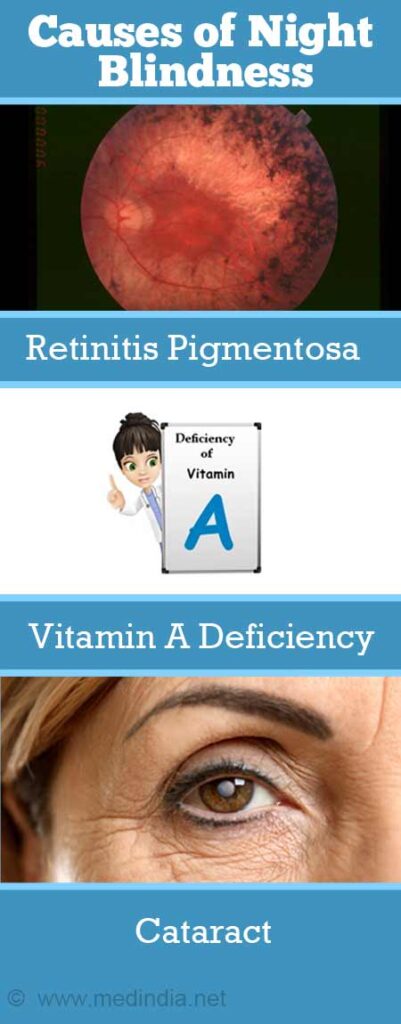If a person were to stop eating vitamin A-containing food, deficiency symptoms would not begin to appear until after stores were depleted-one to two years for a healthy adult but much sooner for a growing child. The results would then be severe and significant. Although vitamin A insufficiency is rare in the United States, it is a significant nutritional issue in underdeveloped countries. The most common vitamin A deficiency diseases are:
Infectious diseases
Night Blindness
Xerophthalmia (Blindness)
Keratinization
- Infectious Diseases
Measles is a deadly contagious illness that claims up to two million children worldwide each year in underdeveloped nations. This severity of the illness often correlates with the degree of vitamin A deficiency; deaths are usually due to related infections such as pneumonia and severe diarrhea. Large dosages of vitamin A lower the chance of death from these infections.
- Night Blindness
Night Blindness is one of the first detectable signs of vitamin A deficiency and permits early diagnosis. The retina in night blindness does not get enough retina to regenerate the light-bleached visual pigments. The person loses the ability to recover promptly from the temporary blindness that follows a flash of bright light at night or to see after the light goes out. In many parts of the world, after the sun goes down, vitamin A-deficient people become night blind: children cannot find their shoes or toys, and women cannot fetch water or wash dishes. They frequently cling to others or remain stuck because of fear that if they try to travel alone, they may slip and fall or get lost.

- Xerophthalmia
Beyond night blindness is total blindness that is failure to see at all. Night blindness is caused by a lack of vitamin A at the back of the eye, the retina whereas total blindness is caused by a lack of vitamin A at the front of the eye, the cornea. Blindness due to vitamin A deficiency, known as xerophthalmia, It is the leading cause of preventable blindness in children under the age of 5, especially in developing countries. xerophthalmia develops in two stages. At first, the whites of the eyes and the cornea become dry and hard, a condition known as xerosis. Foamy spots called Bitot’s spots may appear in the whites of the eyes. Then, corneal xerosis can quickly progress to keratomalacia, the softening of the cornea that leads to irreversible blindness.

Symptoms of keratomalacia include:
Dry, red eyes
Painful eyes
Sensitivity to light
Blurred vision
Cloudy corneas
- Keratinization
A lack of vitamin A has an impact on various surfaces in the body. On the body’s outer surface, the epithilialcells change shape and begin to secreat the protein keratin- the hard, inflexible protein of hairs and nails. The skin becomes dry, rough, and scaly as lumps of keratin accumulate 9keratinization0.
Causes of Vitamin A Deficiency
A number of factors involve in vitamin A deficiency. Some of them are discuss below:
Dietary Insufficiency: The most prevalent reason for vitamin A deficiency is not having enough vitamin A-rich foods in your diet, particularly in places where there’s limited access to a variety of nutritious foods.
Malabsorption Disorders: Some medical conditions, like celiac disease and cystic fibrosis, can make it harder for your body to absorb vitamin A from the food you eat.
Inadequate Liver Function: Your liver is vital for storing and converting vitamin A into a usable form. However, if you have liver problems, it can disrupt this important function and result in a deficiency of vitamin A.
Infancy and Childhood: Babies and young children go through rapid growth, which means their bodies require more vitamin A. This higher demand for vitamin A can make young children more at risk of developing a deficiency.
Inadequate Breastfeeding: Babies who aren’t breastfed and don’t get a proper mix of solid foods are more likely to face the risk of vitamin A deficiency.
Vitamin A Supplements
Most people can get enough vitamin A from their diet, but some people may need to take a supplement. Vitamin A supplements can help to improve vision, boost the immune system, and promote cell growth. They may also help to reduce the risk of certain diseases, such as measles and night blindness.
Who should take vitamin A supplements?
Vitamin A supplements may be recommended for people who:
- Have a limited diet or are unable to absorb vitamin A from food
- Have a condition that increases their need for vitamin A, such as cystic fibrosis, celiac disease, or Crohn’s disease
- Are pregnant or breastfeeding
- Are at risk for vitamin A deficiency, such as infants and children in developing countries
Recommended dose and time of vitamin A supplements
The recommended daily intake of vitamin A for adults is 900 micrograms (mcg) for men and 700 mcg for women. Pregnant women need 770 mcg of vitamin A per day, and breastfeeding women need 1,200 mcg per day.
Vitamin A supplements can be taken with or without food. It is best to take them at the same time each day so that you are less likely to forget.
Side effects of vitamin A supplements
Vitamin A supplements are generally safe when taken at the recommended doses. However, high doses of vitamin A can be toxic and cause side effects such as nausea, vomiting, headache, and blurred vision.
Which vitamin A supplements are the best?
Vitamin A supplements come under a wide range of brands and varieties. It is important to choose a dietary supplement from a reliable company and one that offers the appropriate amount of vitamin A.
Here are a few popular vitamin A supplements:
| Brand | Supplement Name | Dose |
| Nature Made | Vitamin A | 5,000 IU |
| Solgar | Vitamin A | 5,000 IU |
| Now Foods | Vitamin A | 5,000 IU |
| Pure Encapsulations | Vitamin A | 5,000 IU |
| Jarrow Formulas | Vitamin A | 10 |

